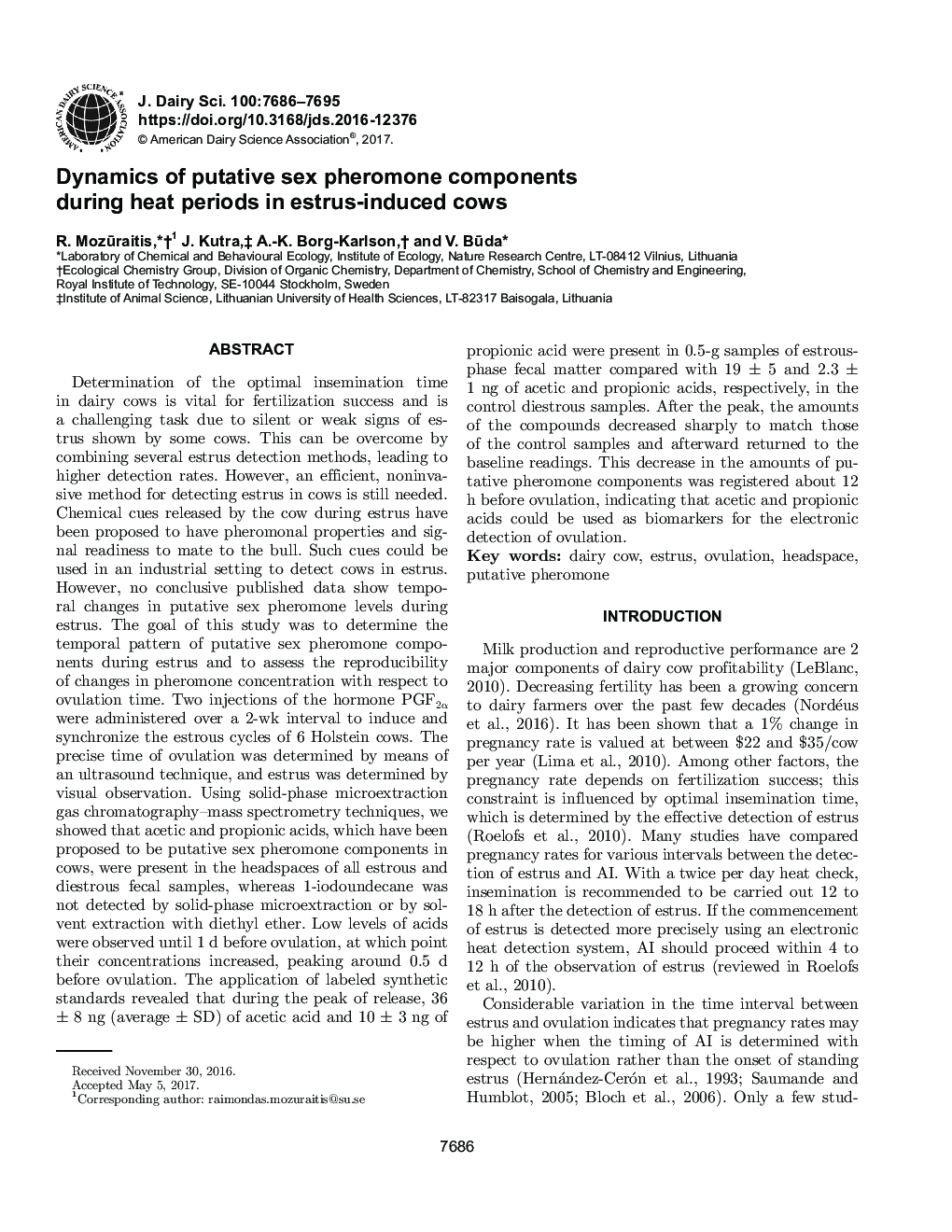| کد مقاله | کد نشریه | سال انتشار | مقاله انگلیسی | نسخه تمام متن |
|---|---|---|---|---|
| 5542124 | 1402514 | 2017 | 10 صفحه PDF | دانلود رایگان |
عنوان انگلیسی مقاله ISI
Dynamics of putative sex pheromone components during heat periods in estrus-induced cows
ترجمه فارسی عنوان
دینامیک مولفه های فرومون جنسیت احتمالی در طول دوره های گرما در گاوهای ناشی از استرفت
دانلود مقاله + سفارش ترجمه
دانلود مقاله ISI انگلیسی
رایگان برای ایرانیان
کلمات کلیدی
گاو شیری، استروس، تخمک گذاری، فضای آزاد، فرومون احتمالی
موضوعات مرتبط
علوم زیستی و بیوفناوری
علوم کشاورزی و بیولوژیک
علوم دامی و جانورشناسی
چکیده انگلیسی
Determination of the optimal insemination time in dairy cows is vital for fertilization success and is a challenging task due to silent or weak signs of estrus shown by some cows. This can be overcome by combining several estrus detection methods, leading to higher detection rates. However, an efficient, noninvasive method for detecting estrus in cows is still needed. Chemical cues released by the cow during estrus have been proposed to have pheromonal properties and signal readiness to mate to the bull. Such cues could be used in an industrial setting to detect cows in estrus. However, no conclusive published data show temporal changes in putative sex pheromone levels during estrus. The goal of this study was to determine the temporal pattern of putative sex pheromone components during estrus and to assess the reproducibility of changes in pheromone concentration with respect to ovulation time. Two injections of the hormone PGF2α were administered over a 2-wk interval to induce and synchronize the estrous cycles of 6 Holstein cows. The precise time of ovulation was determined by means of an ultrasound technique, and estrus was determined by visual observation. Using solid-phase microextraction gas chromatography-mass spectrometry techniques, we showed that acetic and propionic acids, which have been proposed to be putative sex pheromone components in cows, were present in the headspaces of all estrous and diestrous fecal samples, whereas 1-iodoundecane was not detected by solid-phase microextraction or by solvent extraction with diethyl ether. Low levels of acids were observed until 1 d before ovulation, at which point their concentrations increased, peaking around 0.5 d before ovulation. The application of labeled synthetic standards revealed that during the peak of release, 36 ± 8 ng (average ± SD) of acetic acid and 10 ± 3 ng of propionic acid were present in 0.5-g samples of estrous-phase fecal matter compared with 19 ± 5 and 2.3 ± 1 ng of acetic and propionic acids, respectively, in the control diestrous samples. After the peak, the amounts of the compounds decreased sharply to match those of the control samples and afterward returned to the baseline readings. This decrease in the amounts of putative pheromone components was registered about 12 h before ovulation, indicating that acetic and propionic acids could be used as biomarkers for the electronic detection of ovulation.
ناشر
Database: Elsevier - ScienceDirect (ساینس دایرکت)
Journal: Journal of Dairy Science - Volume 100, Issue 9, September 2017, Pages 7686-7695
Journal: Journal of Dairy Science - Volume 100, Issue 9, September 2017, Pages 7686-7695
نویسندگان
R. Mozūraitis, J. Kutra, A.-K. Borg-Karlson, V. Būda,
